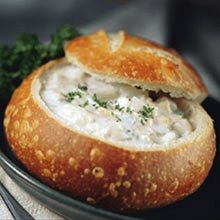
This recipe makes great Kaiser rolls. It's a long one, but worth the effort. It requires a Pate Fermentee that is shown at the end of this recipe.
Kaiser/Hard Rolls
Makes 6 large rolls or 9 smaller rolls.
1 1/2 cups (8 ounces) pate fermentee
2 1/4 cups (10 ounces) unbleached bread flour
3/4 teaspoon plus a pinch (.2 ounce) salt
1 teaspoon (.17 ounce) diastatic barley malt powder
1 teaspoon (.11 ounce) instant yeast
1 large (1.65 ounce) egg, slightly beaten
1 1/2 tablespoons (.75 ounce) vegetable oil or shortening, melted
10 tablespoons
to 3/4 cup (5 to 6 ounces) water, lukewarm (90 to 100 degrees)
Poppy or sesame seeds for topping (optional).
Semolina flour or cornmeal for dusting.
1. Take 8-ounces of the pate fermentee out of the refrigerator 1-2 hour2 before making the dough. Cut it up into about 10 small pieces with a pastry scraper or serrated knife. Cover it with a towel or plastic wrap and let sit for 1-2 hours to take off the chill.
2. Stir together the flour, salt, malt powder, and yeast in a 4-quart bowl (or in the bowl of an electric mixer). Add the pate fermentee, egg, oil, and 10 tablespoons water. Stir (or mix on low speed with the paddle attachment) for 1 minute, or until the ingredients form a ball. If there is still some loose flour, add the remaining 2 tablespoons of water.
3. Lightly dust the counter with flour, transfer the dough to the counter, and begin kneading (or mix on medium speed with the dough hook). Knead for about 10 minutes (6 minutes by machine), adding flour, if needed, to make a dough that is soft and supple, tacky but not sticky. The dough should pass the windowpane test and the internal temperature should register 77 to 81 degrees. Lightly oil a large bowl and transfer the dough to the bowl, rolling it to coat it with oil. Cover the bowl with plastic wrap.
4. Ferment at room temperature for 2 hours, or until the dough doubles in size. If the dough doubles in size before 2 hours have elapsed, remove it, knead it lightly to degas it, and return it to the bowl to continue fermenting until doubled from original size or until 2 hours have elapsed.
5. Remove the dough from the bowl and divide it into 6 to 9 equal pieces (4 ounces for large rolls, 2 2/3 ounce pieces for smaller rolls). Form the pieces into rolls as shown on page 82. (attached) Mist the rounds lightly with spray oil, cover with a towel or plastic wrap, and let the dough relax for 10 minutes. Meanwhile, line a sheet pan with baking parchment, lightly mist it with spray oil, and then dust with semolina flour or cornmeal.
6. Prepare the individual rolls by cutting them with a Kaiser roll cutter or knotting them. Place the rolls, cut side down, on the parchment, mist lightly with spray oil, and loosely cover the pan with plastic wrap or a food-grade plastic bag.
7. Proof the rolls for 45 minutes at room temperature, then flip them over so the cut or folded side is facing up. Mist again with spray oil, cover the pan, and continue proofing for another 30 to 45 minutes, or until the rolls are double their original size.
8. Preheat the oven to 425 degrees with the oven rack on the middle shelf. Uncover the rolls and prepare them for baking. If you want seeds on your rolls, mist them with water and sprinkle poppy seeds over the top. If not, just mist them with water.
9. Place the pan in the oven, spray the oven walls with water, and close the door. After 10 minutes, rotate the pan for even baking and lower the oven setting to 400 degrees. Continue baking until the rolls are a medium golden brown and register approximately 200 degrees in the center. This will take 15 to 30 minutes for large rolls, or less for smaller rolls.
10. Remove the rolls from the pan and transfer to a cooling rack. Wait at least 30 minutes before serving.
Pate Fermentee
Makes 16 to 17 ounces.
1 1/8 cups (5 ounces) unbleached all-purpose flour
1 1/8 cups (5 ounces) unbleached bread flour
3/4 teaspoon (.19 ounces) salt
1/2 teaspoon (.055 ounce) instant yeast
3/4 cup to 3/4 cup plus (6 to 7 ounces) water, at room temperature plus
2 tablespoons of additional water
1. Stir together the flours, salt and yeast in a 4-quart bowl (or in the bowl of an electric mixer). Add 3/4 cup of the water, stirring until everything comes together and makes a coarse ball (or mix on low speed for 1 minute with the paddle attachment). Adjust the flour or water, according to need, so that the dough is neither too sticky nor too stiff. (It is better to err on the sticky side, as you can adjust easier during kneading. It is harder to add water once the dough firms up.)
2. Sprinkle some flour on the counter and transfer the dough to the counter. Knead for 4 to 6 minutes (or mix on medium speed with the dough hook for 4 minutes), or until the dough is soft and pliable, tacky but not sticky. The internal temperature should be 77 to 81 degrees.
3. Lightly oil a bowl and transfer the dough to the bowl, rolling it around to coat it with oil. Cover the bowl with plastic wrap and ferment at room temperature for 1 hour, or until it swells to about 1 1/2 times its original size.
4. Remove the dough from the bowl, knead it lightly to de-gas, and return it to the bowl, covering the bowl with plastic wrap. Place the bowl in the refrigerator overnight. You can keep this in the refrigerator for up to 3 days, or freeze it in an airtight plastic bag for up to 3 months.

